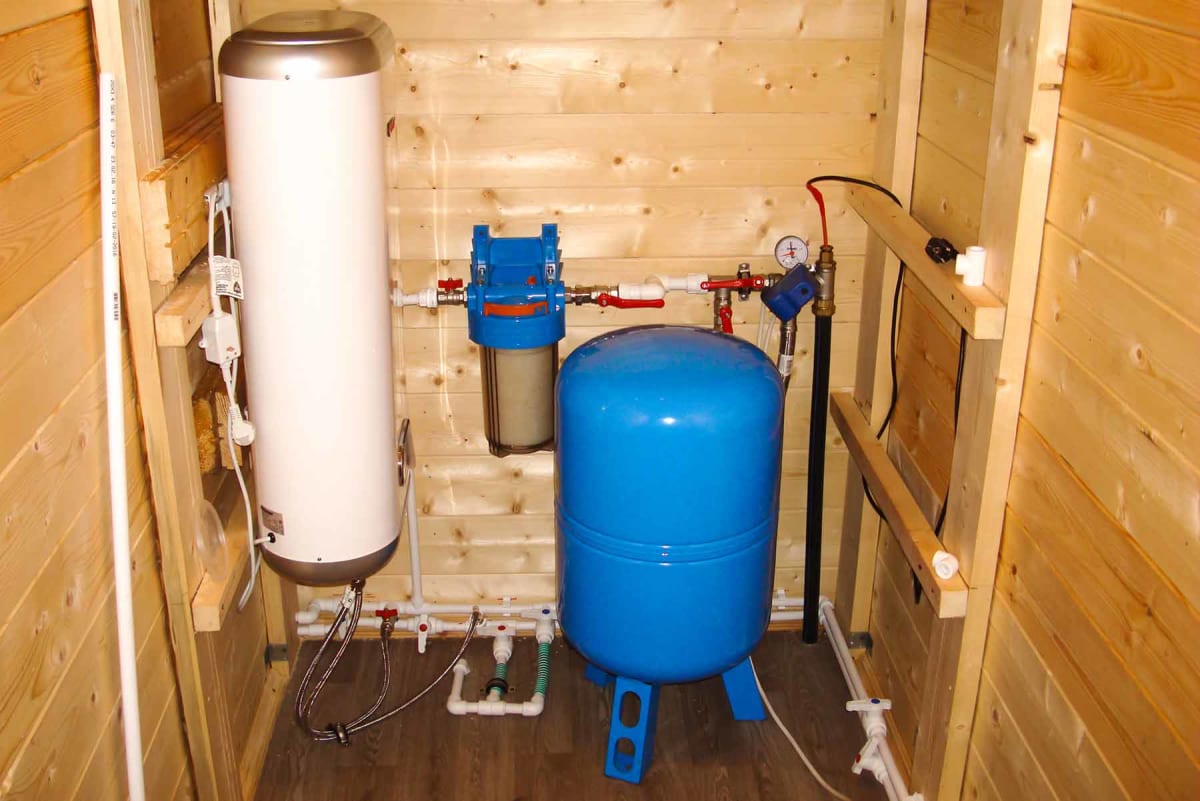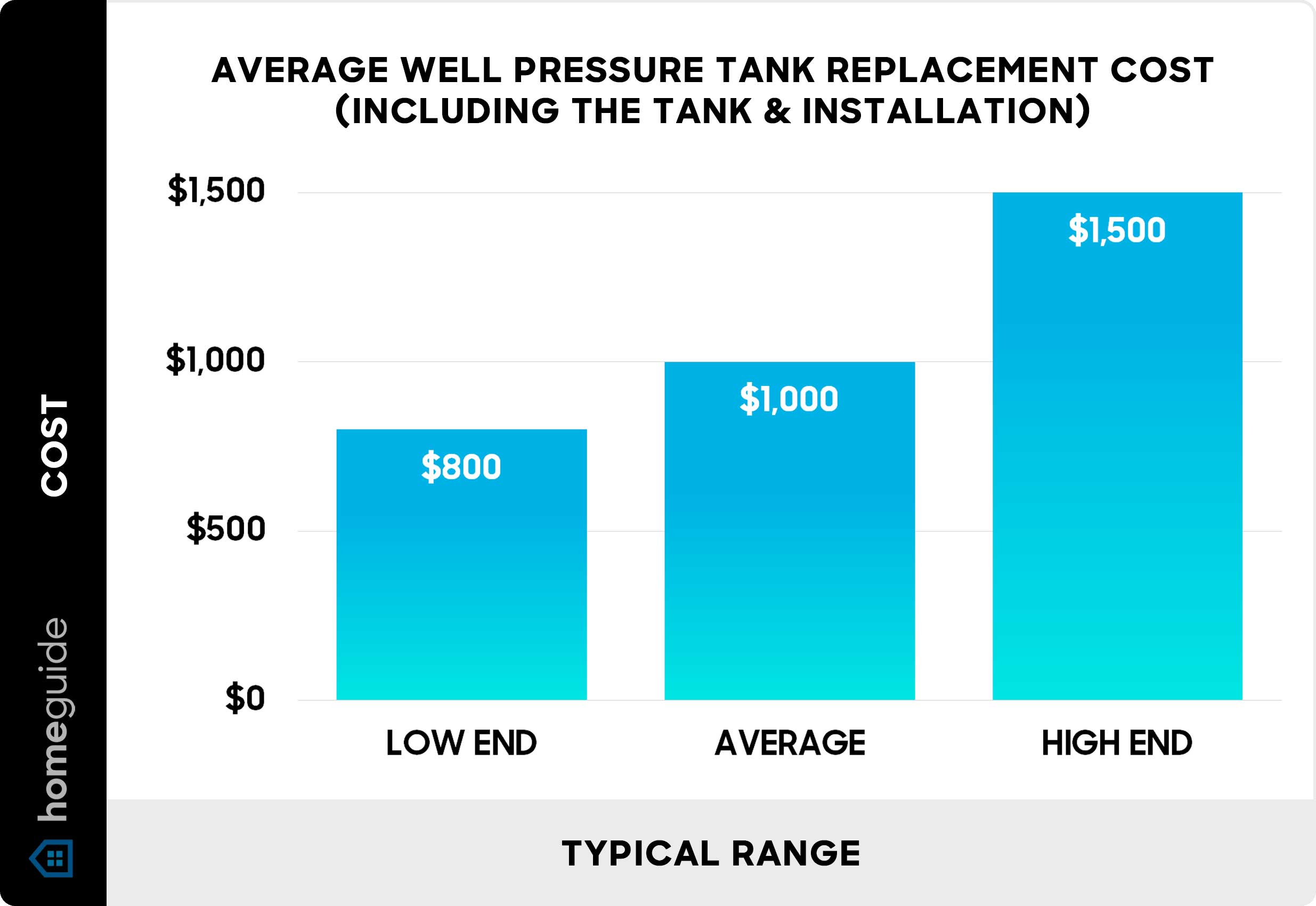
How much does it cost to replace a well pressure tank?
How much does it cost to replace a well pressure tank?
$800 – $1,500 average total cost (labor + materials)
Average well pressure tank replacement cost
The average cost to replace a well pressure tank is $800 to $1,500, including the tank and professional labor. Well pressure tank replacement costs depend on the tank size and type, local labor rates, and the job complexity. Costs increase for larger tanks or those in difficult-to-reach areas.

| National Average Cost | $1,000 |
| Minimum Cost | $450 |
| Maximum Cost | $3,000+ |
| Average Range | $800 to $1,500 |
*Including the tank and professional installation
Well tank replacement cost by size
The tank size is the biggest factor in the replacement cost. Larger tanks cost more but provide greater water storage capacity and reduce the pump cycling frequency, which can extend the pump's lifespan.
| Well pressure tank size (gallons) |
Average price (tank only) |
Average total cost (with installation) |
|---|---|---|
| 20 – 29 | $200 – $500 | $450 – $1,000 |
| 30 – 39 | $300 – $850 | $550 – $1,350 |
| 40 – 59 | $350 – $1,100 | $600 – $1,600 |
| 60 – 79 | $500 –$1,300 | $750 – $1,800 |
| 80 – 99 | $600 – $1,800 | $850 – $2,300 |
| 100 – 119 | $850 – $2,000 | $1,100 – $2,500 |
| 120 – 139 | $900 – $2,500+ | $1,150 – $3,000+ |
Well pressure tank replacement cost factors
Several factors affect the cost to replace a well pressure tank, including the tank size and type, local labor rates, and the complexity of job:
Tank capacity
The tank capacity directly impacts both the purchase price and installation costs. Larger tanks require more robust mounting systems and may need additional piping modifications. The tank's gallon capacity determines how much water it can store under pressure.
Tank type
There are three main types of well pressure tanks, each with different price points and performance characteristics:
Diaphragm pressure tanks feature a flexible rubber diaphragm that separates water from air, preventing air absorption into the water. These tanks cost more up front but offer superior performance and longevity.
Bladder pressure tanks use a replaceable bladder to separate water and air. They provide excellent water quality and are easier to service than diaphragm tanks, with moderate pricing.
Air-over-water pressure tanks are the most basic and affordable option. Water sits directly on top of compressed air, but these tanks require more maintenance as air gradually dissolves into the water over time.
Labor cost
The labor cost to replace a well pressure tank ranges from $250 to $500+ depending on the complexity and labor rates. Costs increase if the job requires rerouting pipes or replacing components. Plumber rates range from $75 to $150 per hour on average, with higher rates for emergency plumbing services.
Site access
Site accessibility significantly impacts installation costs. Tanks located in easily accessible areas like basements or utility rooms cost less to replace than those in cramped crawl spaces or requiring excavation.
Above-ground installations are more straightforward and less expensive than underground tank replacements, which may require digging and additional waterproofing measures.
Other repairs
Costs increase if other parts like the pressure gauge, pressure switch, or well pump also require replacing. Well pump replacement costs $1,000 to $2,500+, depending on the pump type and size.
Signs your well pressure tank needs replacement
Watch for these warning signs of a failing pressure tank:
Water pressure fluctuations indicate the tank isn't maintaining consistent pressure. You may notice pressure dropping during use or inconsistent flow from faucets.
Short pump cycling occurs when the pump turns on and off frequently, even with minimal water use. This puts excessive wear on the pump and increases energy costs.
Waterlogged tanks have lost their air charge, causing the pump to run every time you turn on a faucet. You can test this by tapping the tank. A waterlogged tank sounds solid rather than hollow.
Visible corrosion or rust on the tank exterior indicates internal deterioration. Severe corrosion compromises the tank's structural integrity and water quality.
A professional well inspection costs $250 to $550 and can help identify potential issues before they lead to complete failure.
Well pressure tank FAQs
How does a well pressure tank work?
A well pressure tank stores water under pressure, reducing the frequency of pump cycling and ensuring consistent water flow throughout your home. When you turn on a faucet, pressurized water flows from the tank. As the tank empties, the pressure drops until it reaches a preset level, triggering the well pump to refill the tank.
The tank contains an air chamber that compresses as water enters, creating the pressure needed for water distribution. This system protects your well pump from excessive cycling and provides immediate water availability.
How long do well pressure tanks last?
Well pressure tanks last 10 to 15 years on average, depending on the water quality, usage patterns, and maintenance. Homes with hard water or high mineral content may experience shorter tank life due to increased corrosion and mineral buildup.
Regular maintenance, including checking the air pressure and inspecting the tank for leaks, can extend the tank's life.
What size well pressure tank do I need?
The correct well pressure tank size for your home depends on your household's water usage, pump capacity, and desired performance. As a general guideline:
For homes with 1 to 2 people and low water usage, a 20- to 40-gallon tank may suffice.
Families of 3 to 4 people benefit from 40- to 60-gallon tanks.
Larger families or homes with high water demand may need 80+ gallon tanks.
Consult with a well professional to determine the optimal tank size for your specific situation, considering factors like the pump capacity, water usage patterns, and system pressure requirements.

Getting estimates from well repair companies
Follow these tips when choosing a well repair company near you:
Read reviews on HomeGuide and Google to gauge the company's reputation and work quality.
Get quotes from at least three well repair pros to compare.
Select a company that has been in business for 5+ years.
Confirm the company is licensed and insured.
Request a written estimate detailing all the costs associated with the project.
Ask about warranties for the well pressure tank and the company's work.
Questions to ask well pump repair contractors
Ask these important questions to ensure you hire the best well repair company for the job:
How long have you been in business?
Are you licensed and insured?
What brand of well pressure tank do you recommend for my home?
What kind of warranty does the tank come with?
Do you offer any warranties on your work?
How long will the tank replacement take?
Does your estimate include disposal of my old well tank?
Do you perform any maintenance or well pump inspections?